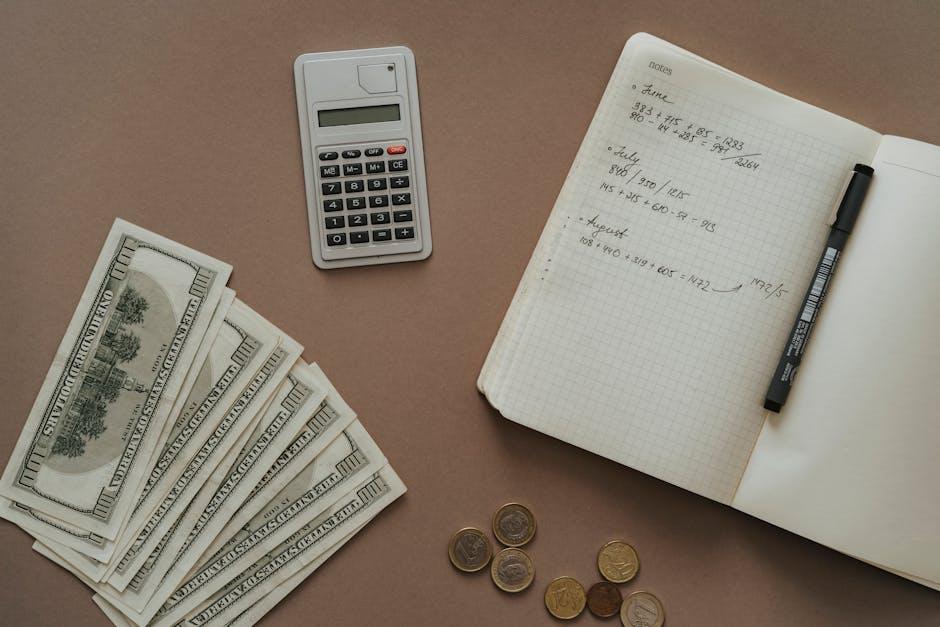In the pursuit of financial freedom, the winding path often leads through the intricate maze of budgeting. Yet, many find themselves lost, overwhelmed by bills and expenses that seem to multiply with each passing month. However, a monthly budget, when crafted thoughtfully, can be a powerful tool that not only organizes your finances but also empowers you to take control of your future. By embracing this practice, you can unlock the door to financial independence, transforming your relationship with money from one of anxiety to one of clarity and confidence. In this article, we will explore the essential elements of a successful monthly budget and how making simple adjustments can pave the way toward achieving your financial goals.
Understanding the Essentials of a Practical Monthly Budget
Creating a practical monthly budget is crucial for achieving financial stability and freedom. By tracking your income and expenses, you can make informed decisions that promote healthier financial habits. Here are some essentials to consider when developing your monthly budget:
- Assess Your Income: Start by determining your total monthly income. This may include your salary, side hustles, or any other sources of income. Use your net income (after taxes) for accuracy.
- Track Your Expenses: List all your monthly expenses, categorizing them into fixed (rent/mortgage, utilities) and variable (groceries, entertainment) expenses. This will provide a clear picture of where your money goes.
- Set Clear Financial Goals: Whether you’re saving for a vacation, paying off debt, or building an emergency fund, clear goals can motivate you to stick to your budget.
- Prioritize Savings: Aim to allocate at least 20% of your income to savings. This includes retirement funds (like a 401(k) or IRA) and emergency savings accounts. Use high-yield savings accounts to maximize your returns.
- Review and Adjust Regularly: A budget is not static. Regularly review your budget to adjust for changes in income, expenses, or financial goals. This will help you stay on track over time.
| Expense Category | Typical Monthly Amount |
|---|---|
| Rent/Mortgage | $1,200 |
| Utilities | $300 |
| Groceries | $400 |
| Transportation | $250 |
| Insurance (Health, Auto) | $450 |
| Entertainment | $200 |
| Miscellaneous | $100 |
Utilizing budgeting tools can streamline this process. Consider platforms like Mint or YNAB (You Need A Budget); both allow for easy expense tracking and provide insights into your budgeting habits.
Finally, remember that sticking to a budget requires discipline and patience. Celebrate small victories along the way, and don’t be too hard on yourself if things don’t go as planned. Adapting your budget to meet your actual spending habits will ultimately lead to financial health.

Identifying Your Income and Expenses for Clarity
Understanding your income and expenses is the first step toward achieving financial clarity and ultimately, financial freedom. Here’s how to effectively identify and categorize them:
Income Identification
Your income is any money that comes into your household. This can include various sources:
- Salary: Your monthly paycheck before taxes and other deductions.
- Boni: Any extra earnings from employer incentives.
- Investment Income: Dividends, interest from savings accounts, or rental income.
- Side Hustles: Money earned from freelance work or part-time jobs.
- Government Benefits: Social Security, unemployment benefits, or child support.
Expense Tracking
Next, it’s vital to document all your expenses. Categorizing them can help manage spending and identify areas for savings:
- Fixed Expenses: Regular payments that don’t change, like rent or mortgage, car payments, and insurance premiums.
- Variable Expenses: Costs that fluctuate, such as groceries, dining out, and utility bills.
- Discretionary Expenses: Non-essential purchases, including entertainment, hobbies, and subscriptions.
- Savings Contributions: Amounts set aside for emergencies or retirement plans like a 401(k) or IRA.
Creating a Budget Table
Here’s a simple budget table to help visualize your income against your expenses:
| Category | Amount ($) |
|---|---|
| Total Income | 3,500 |
| Fixed Expenses | 1,200 |
| Variable Expenses | 800 |
| Discretionary Expenses | 300 |
| Savings Contributions | 400 |
| Total Expenses | 2,700 |
| Net Gain/Loss | 800 |
By clearly identifying your income and expenses, you can adjust your spending and increase your savings. Regularly revisiting this information can provide a proactive approach to keep your finances in check. Remember, financial clarity is the key to unlocking your financial freedom!

Strategic Savings: Building an Emergency Fund and Future Investments
Creating a robust financial future starts with establishing a solid emergency fund and making informed future investments. These components not only provide security but also pave the way for financial freedom.
Building an Emergency Fund
An emergency fund acts as a financial safety net, allowing you to cover unexpected expenses without derailing your financial plans. Here’s how to get started:
- Set a Realistic Goal: Aim to save three to six months’ worth of living expenses. This may vary based on personal circumstances, such as job stability and household expenses.
- Choose the Right Account: Save your emergency fund in a high-yield savings account. This ensures your money is accessible while earning interest. Consider banks like Ally or Marcus by Goldman Sachs for competitive rates.
- Automate Your Savings: Set up automatic transfers from your checking account to your savings account each month. This “pay yourself first” approach makes saving a priority.
Future Investments
Once you have a comfortable emergency fund, redirect your focus to future investments that can grow your wealth over time.
- Retirement Accounts: Maximize contributions to tax-advantaged accounts like 401(k)s or IRAs. Employers often match contributions, which is essentially free money. Take advantage of this benefit.
- Brokerage Accounts: For more flexibility, consider opening a brokerage account to invest in stocks, ETFs, or mutual funds. Robinhood and Fidelity offer user-friendly platforms for beginners.
- Diversification: Spread your investments across various asset classes to mitigate risk. Include a mix of stocks, bonds, and possibly real estate through REITs.
Sample Emergency Fund Savings Plan
| Monthly Income | Monthly Expenses | Target Emergency Fund (3 Months) | Recommended Monthly Savings |
|---|---|---|---|
| $5,000 | $3,000 | $9,000 | $300 |
| $7,000 | $4,500 | $13,500 | $450 |
| $10,000 | $6,000 | $18,000 | $600 |
By establishing a well-funded emergency savings account and strategically investing for the future, you place yourself on a path toward long-term financial stability. Prioritizing these steps can transform your approach to managing money and achieving financial independence.

Staying on Track: Tools and Tips for Budgeting Success
Staying on top of your budget can seem challenging, but with the right tools and tips, you can transform your financial management into a seamless experience. Here are some valuable strategies and resources to help you maintain a successful budget:
- Utilize Budgeting Apps: Consider downloading budgeting apps like Mint or YNAB (You Need a Budget). These apps connect with your bank accounts, allowing you to track your spending and categorize expenses effortlessly. They often feature alerts that notify you when you’re nearing your budget limits.
- Spreadsheet Templates: If you prefer a hands-on approach, use free spreadsheet templates available on platforms like Google Sheets or Excel. These templates can help you visualize your finances, providing detailed insights into where your money goes each month.
- Establish Financial Goals: It’s easier to stick to your budget when you have clear objectives. Identify short-term and long-term goals, whether it’s saving for a vacation, building an emergency fund, or paying off debt. Keeping these goals in mind will motivate you to stay disciplined.
- Automate Savings: Set up automatic transfers into your savings account right after you receive your paycheck. This way, you prioritize savings before considering your spending. Many banks offer tools that allow you to automate this process seamlessly.
- Monitor & Adjust: Review your budget regularly. Monthly check-ins can help you gauge your progress and identify areas where you can cut back. Flexibility is key; adjust your budget as needed based on changing circumstances.
- Accountability Partners: Share your budgeting goals with a trusted friend or family member. Regularly discussing your financial progress can provide the support you need to stay on track.
For tech-savvy users, consider exploring these budgeting tools that can aid in your financial journey:
| Tool/App | Description | Best For |
|---|---|---|
| Mint | Tracks spending, creates budgets, and offers personalized tips. | Users who want a comprehensive overview of their finances. |
| YNAB | Focuses on proactive budgeting and encourages every dollar to have a job. | Those looking for a more hands-on approach to budgeting. |
| EveryDollar | Allows you to plan your budget and track expenses. | Individuals wanting straightforward budget management. |
| PocketGuard | Simplifies tracking by showing how much disposable income you have. | People looking for ease in monitoring their disposable income. |
By employing these tools and strategies, you’ll not only stay organized but also gain a clearer understanding of your financial situation, paving the way toward achieving your financial freedom.

The Way Forward
As we wrap up our exploration of unlocking your financial freedom with a monthly budget that works, remember that the journey to financial independence starts with awareness and intention. By embracing the principles outlined in this article, you are not only setting the stage for a healthier relationship with your money but also empowering yourself to make informed choices that align with your goals.
Budgeting might seem daunting at first, but with patience and practice, it can transform into a refreshing tool for managing your finances. Celebrate each small victory along the way, and don’t hesitate to reassess your budget as your life and financial circumstances evolve. Financial freedom is not just a destination; it’s a lifestyle choice that opens up possibilities and opportunities. Start today, and watch your financial landscape change for the better.














